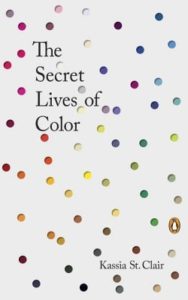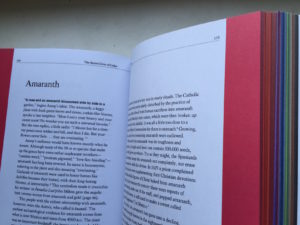The Secret Lives of Color fairly leaped off the display table at me. Once I had it in my hands, I had to own it. The book itself is an argument for books as tangible objects, thanks to the efforts of designer James Edgar and the production team at Penguin who all made it such a pleasure to pick up, leaf through, and read.
The main texts of the book tell the stories of 75 different colors, and St. Clair’s efforts to “take a different shade and pull it apart tat the seams to discover its hidden mysteries. When was it fashionable? How and when was it made? Is it associated with a particular artist or designer or brand? What is its history?” (p. 10) Naples yellow, orpiment, Mountbatten pink, cochineal, Tyrian purple, ultramarine, celadon — who could resist even the names? Each story’s page has generous margins of the appropriate color, so that looking at the book’s side or flipping through it is like zipping through the spectrum.
And what stories! I can’t count how many times I read a description of the process of making a pigment and wondered how on earth people discovered the process. The purple that the Caesars wore was made from two Mediterranean shellfish. To get the color, the Romans cracked open the shellfish, squeezed a gland that crossed the body and captured “a single drop of clear liquid, smelling of garlic … Within moments, the sunlight would turn the liquid first pale yellow, then sea green, then blue, and finally a dark purple-red.” (p. 162) The best color, however, came from mixing the fluids from both kinds of shellfish. How did people come up with the idea of squeezing snails for colors? Not only that, but the next part of the process was to place the liquid in a vat of stale urine for 10 days before adding the cloth. Who thinks, “Well, I’ll just put some cloth into week-old pee and see what happens”? Who even makes these connections? In the case of Tyrian purple, it’s even trickier: “Since each specimen contained a single drop [of the crucial liquid], it took around 250,000 to make an ounce of dye.” (p. 163) Somewhere along the way, people discovered that cracking open a quarter million snails, squeezing one of their organs, and then taking the resulting liquid and mixing it with stale urine for a week or more was a great way to make a color. I’m torn as to whether this is testimony to humanity’s infinite ingenuity or proof of the absurdity of the universe.
Gamboge, a yellow that St. Clair describes as “so bright and luminous it almost seemed fluorescent,” (p. 80) is made from the sap of a particular tree in Cambodia. A particular tree that is at least ten years old, whose sap has been collected and left to harden for more than a year. Coloration is not its only attribute. In 1836, gamboge was described as “an excellent and powerful purgative.” St. Clair continues, “Just a small amount could produce ‘profuse watery discharges’; larger doses could be fatal. Workers who crushed gamboge at Winsor & Newton would have to rush to the toilet once an hour while working with it.” (p. 81)
Mummy, a rich brown, was made of just that. “There was some debate as to which bits of the mummy to use to get the best and richest browns—recommended for transluscent glazing layers for shadows and skin tones.” (pp. 254–55) Toward the end of the nineteenth century, though, artists came to dislike some of the color’s traits (permanency and finish, writes St. Clair), and were unhappy about its origin. She notes that a London art shop that had opened in 1810 ran out of mummy in the 1960s.
The other great change in the nineteenth century was the coming of applied chemistry to the science and industry of pigments. For centuries, ultramarine had been made from ground up lapis lazuli. In Europe, the main source was a single mine in the mountains of Afghanistan. As a result, it was enormously expensive. In the late 1820s, however, a French chemist discovered a way to synthesize ultramarine. In 1856, a London teenager discovered a way to make a purple dye, which he named mauve after the French for mallow plant, from coal tar. That substance yielded a large family of manufactured colors, beginning with magenta in 1858 and continuing with a yellow, two violets, green, several blues and a black in the next few years.
Contemporary searches for new pigments are more systematic, but there is still a large element of chance and surprise, as this story of new colors attests.
The stories of pigments are full of unexpected wonders, and The Secret Lives of Colors shares them in all their delightful vividness.


